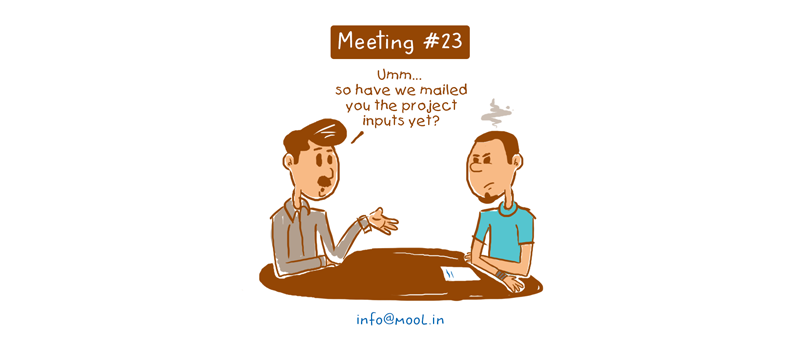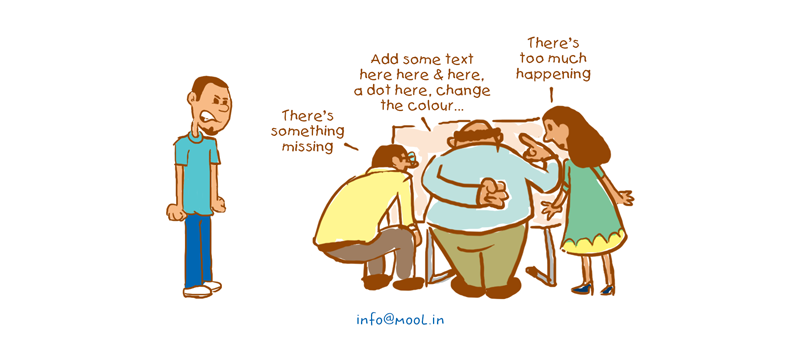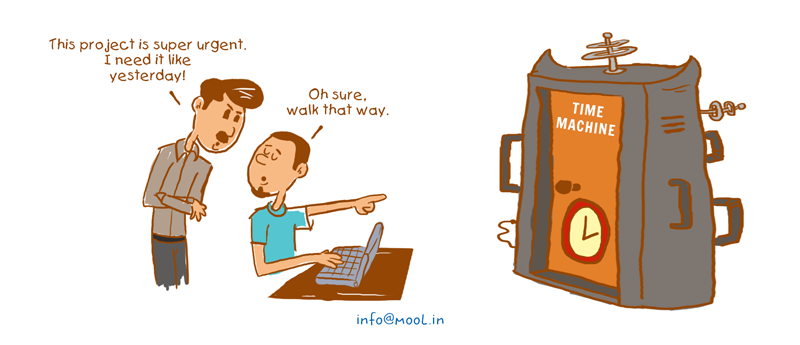There are several reasons why projects don’t turn out to be successful, but in our experience, here are some that recur most frequently.
1. No Ownership or Intent
A need within the client’s business is identified, quotes are sought, vendors are shortlisted and, after much ado, one gets selected. What could go wrong…

Unfortunately, we can end up with a client or an agency that doesn’t really care about the outcome. This can be due to a variety of factors, but it is often because the success of the project isn’t on people’s lists of KRAs. So even if nothing happens and valuable business resources are wasted, it’s no skin off anybody’s back. Boo.
One of the things we do at Mool to avoid such scenarios is to set fixed project timeframes along with timeline-associated payment milestones. In addition, we ensure that there is one person within our team who is responsible for the completion (and success) of the engagement. This helps to establish a sense of purpose and urgency to every project activity.
2. Layered or Complex Decision Making
Many an engagement have died silent deaths at the hands of individuals and committees with divergent objectives and conflicting expectations. We can’t tell you how many times highly effort-intensive content and design endeavours have been laid to waste by that one person or group of people taking ‘the final call’.

Despite presenting concrete ideas along with a proof of concept, getting the client sign-off and working on a job for weeks while keeping the client point-of-contact in the loop, it isn’t till that all-important meeting with the ‘final decision-maker’ that all hell breaks loose.
For our part at Mool, we make every attempt to involve key stakeholders at every step during engagements to minimize rework, avoid the frustration of a zillion iterations and retain the joy of doing what we love – crafting great communication!
3. Unrealistic Timelines
Among the many things we dread on projects is when clients say things like, ‘We needed it like yesterday’. Or worse still, when one of our team members agrees to a ridiculous timeline in an attempt to win the business.

A services business like ours is all about dealing with people and getting people to work with other people in some sort of harmony. This is never possible when folks are short on sleep, on edge and drinking their morning cup of coffee in office without brushing their teeth.
Bringing out a good product requires high quality effort. High quality effort doesn’t come from frustrated, sleep-deprived souls. We love doing good work for our customers. Set your partners up to succeed by planning your requirements in time. Please.
4. Too-Keen-To-Please Syndrome
Agencies, in an effort to acquire new business, sometimes make promises to clients they can’t keep. We made this mistake in our early days. Sound editing? Of course, we can get it done. 3D animation? Hell yes. Send a man to the moon? Yea… wait, what?!

Over time, we’ve recognised what we’re good at and stuff where don’t possess the requisite capabilities. It’s helped keep customers happy, led to longer term relationships with them and brought down stress levels by many notches. 99% of agencies can’t do everything in-house. Nor can we.
5. Unwillingness to Document & Define
People underestimate the importance of this in creative work – the need to spell out what you want. Whether you’re a client or an agency, we both have to put in the hard yards to make any engagement succeed. The project suffers when the onus is put on the other party to do all the “unglamorous” tasks like taking notes, filling forms, picking up key insights in conversations and so on.

Memories are weaker than they’ve ever been. Can you even recall your closest friend’s mobile number without checking your smartphone? Chances are low. And we’re expecting each other to remember things like verbal briefs for a mailer about an insurance claim settlement process? Have a heart. Document stuff. A few minutes of effort can save hours of pain and frustration later on.
6. Moving Targets
How often have you started off working on a corporate website before ending up creating an absolute abomination of a web page? It happens to the best of us in the early days – mainly because clients can change what they want. While this is fine, it’s important that everyone involved on a project defines what its scope is.

We can’t commit to creating a company brochure initially, go through countless rounds of feedback and then end up with something that looks like a massive product catalog. Both client and agency need to set a target, define what’s included, limit the number of iterations per task, and agree to costs. Anything beyond this is either done at an extra cost or unexecutable given the budget constraints.
Summing Up
As you can see, most of these reasons why projects fail aren’t complex. It’s primarily about taking the time and effort to get the simple things right. When this foundation is in place, engagements generally chug along smoothly with the odd hiccup.

